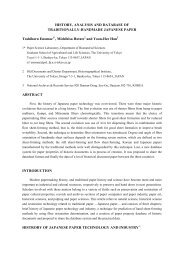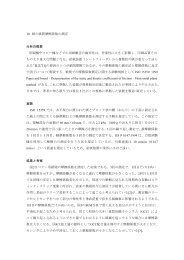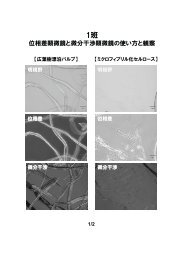Analysis of Historical Documents from a Viewpoint of Paper Science
Analysis of Historical Documents from a Viewpoint of Paper Science
Analysis of Historical Documents from a Viewpoint of Paper Science
Create successful ePaper yourself
Turn your PDF publications into a flip-book with our unique Google optimized e-Paper software.
<strong>Analysis</strong> <strong>of</strong> <strong>Historical</strong> <strong>Documents</strong> <strong>from</strong> a <strong>Viewpoint</strong> <strong>of</strong> <strong>Paper</strong> <strong>Science</strong><br />
orientation angle, there were two angles calculated — 0 º<br />
and 90 º (about 180 º is almost equal to 0 º). These two<br />
angles were not systematically distinguished <strong>from</strong> the<br />
written side to the non-written side. However, this<br />
tendency contrasts with that <strong>of</strong> Japanese paper with the<br />
orientation angle indeed mostly <strong>of</strong> 90 º regardless <strong>of</strong><br />
what kind <strong>of</strong> two-sidedness.<br />
Fig. 6 shows a result for the Daitokuji document papers.<br />
By the typical, but non-systematic classification method<br />
<strong>from</strong> viewpoints <strong>of</strong> such as fiber sources, presence <strong>of</strong><br />
additives like rice powder (if present, it is called<br />
“suibara”) and presence <strong>of</strong> a striped-wrinkle pattern<br />
(“hikiawase”), papers manufactured in the medieval<br />
times can be sorted as shown in this figure. However,<br />
there is no significance with the order <strong>of</strong> the paper<br />
category names or the data plot order in each paper<br />
category. In most samples and most paper categories, the<br />
written side had higher anisotropy. This fact means that<br />
the screen side was selected for writing because every<br />
formed wet sheet is spread over a wooden drying board<br />
usually with the screen side in contact with the board<br />
surface and the screen side becomes smoother than the<br />
top side. But, the Shukushi papers showed the opposite<br />
result. Shukushi means recycled paper and has a<br />
remarkable screen mark with dark lines where residual<br />
Anisotropy<br />
Orientation angle, degree<br />
1.3<br />
1.2<br />
1.1<br />
1.0<br />
210<br />
180<br />
150<br />
120<br />
90<br />
60<br />
30<br />
0<br />
(a)<br />
11C<br />
(b)<br />
11C<br />
L13C-<br />
E14C<br />
L13C-<br />
E14C<br />
M14C L14C 15C 16C<br />
Year<br />
Written side<br />
Non-w ritten side<br />
Written side<br />
Non-w ritten side<br />
M14C L14C 15C 16C<br />
Year<br />
Fig. 5 Fiber orientation intensity (a) and angle (b) <strong>of</strong> Korean ancient<br />
documents. In symbols, L, M and E denotes “late”, “mid” and<br />
“early”, respectively.<br />
side.<br />
A<br />
s is mentioned earlier, Japanese writers <strong>of</strong> letters have<br />
customarily used two sheets if the second sheet was<br />
blank. For such double sheet letters, two sheets were first<br />
taken together <strong>from</strong> a paper stack where sheets were<br />
stacked all with the smooth side face up. Text started to<br />
be written usually on the smooth side <strong>of</strong> the first sheet.<br />
Then, the two sheets together were turned over to go to<br />
the second page if necessary. Table 1 shows the fiber<br />
orientation anisotropy <strong>of</strong> the two sides <strong>of</strong> the two each<br />
sheet as well as the estimated situation how the sheets <strong>of</strong><br />
the double sheet letters in the Daitokuji document were<br />
handled for writing. The regular pattern is that the<br />
written side <strong>of</strong> the first sheet and the unwritten side <strong>of</strong><br />
the second sheet is the smoother side, that is, the side<br />
contacting a wooden drying board (traces <strong>of</strong> annual rings<br />
were observed on this side and the figure <strong>of</strong> anisotropy is<br />
denoted by “Brd” in the table). This regular pattern was<br />
observed with 15 letters with the exception <strong>of</strong> 3 letters as<br />
denoted by “One upside down”. Concerning the drying<br />
process, the screen side is regularly in concordance with<br />
the “Brd” side, but the discordance was observed with 6<br />
letters (247-1, 469-1, 535-1, 788-1, 1509-1 and 1543-1).<br />
The result <strong>of</strong> the fiber orientation analysis revealed that<br />
such a reverse drying — the top side attached on a<br />
wooden drying board — was not too exceptional.<br />
C<br />
ONCLUSIONS<br />
A<br />
nondestructive method <strong>of</strong> image analysis using fast<br />
Fourier transform has been developed to analyze<br />
anisotropy and angle <strong>of</strong> fiber orientation <strong>of</strong> paper<br />
surfaces. When this method was applied to contemporary<br />
Korean and Japanese papers, they showed their own<br />
characteristics in accordance with the motion <strong>of</strong> a<br />
papermaking screen. Anisotropy <strong>of</strong> fiber orientation was<br />
found to be higher for flow-sheet forming and lower for<br />
still-sheet forming as a result <strong>of</strong> anisotropy <strong>of</strong> model<br />
papers hand-made in laboratory. Moreover, the<br />
anisotropy was always higher for the screen side than for<br />
the top side, thus meaning that surface fiber orientation is<br />
possible to distinguish the two sides <strong>of</strong> paper <strong>of</strong> which<br />
papermaking history is unknown. An application <strong>of</strong> this<br />
technique to actual historical documents evidenced that<br />
wrapping papers were used as envelops with a lateral<br />
side up, namely, after rotating 90 degrees. A variety <strong>of</strong><br />
cultural habits in writing letters was revealed by<br />
discrimination <strong>of</strong> the two sides.<br />
Indian ink particles collected. This is the reason why<br />
writers avoided the screen side <strong>of</strong> Shukushi for<br />
brushstrokes. The fiber orientation analysis helped to<br />
know that it was the screen side with the higher<br />
anisotropy that had a screen mark and that ancient<br />
writers used the top side for writing in spite <strong>of</strong> the rough<br />
2006 Pan Pacific Conference 151

















